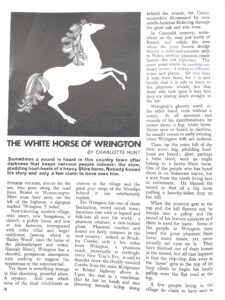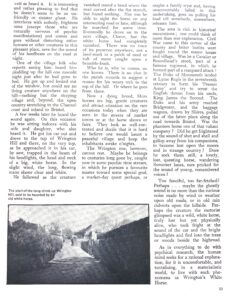

Prediction Magazine May 1969
THE WHITE HORSE OF WRINGTON
BY CHARLOTTE HUNT
Sometimes a sound is heard in this country town after darkness that keeps nervous people indoors: the slow, plodding hoof-beats of a heavy Shire horse. Nobody knows his story and only a few claims to have seen him.
SUMMER VISITORS, BOUND for the sea, who pour along the road from Bristol to Weston-super-Mare must have seen, on the left of the highway, a signpost marked ‘Wrington 5 miles.
Now a thriving, modern village, with smart, new bungalows, a church, a public house and one or two factories, interspersed with older villas and larger residences (among which is ‘Barley Wood’, once the home of the philanthropist and writer, Hannah More), Wrington has a cheerful, prosperous atmosphere with nothing to suggest the mysterious or the supernormal.
Yet there is something strange in this charming, peaceful place. A mystery. And one which none of the local inhabitants or visitors to the village and the great grey range of the Mendips behind it can satisfactorily explain.
For Wrington has one of those fascinating, weird occult manifestations met with in legend and folk-lore all over the world: a phantom creature, a non-human ghost. Phantom coaches and horses are fairly common in the west country; indeed, at Brock-ley Combe, only a few miles from Wrington, a phantom coach, punctually at midnight every New Year’s Eve, is said to thunder down the thickly-wooded Combe from the main Bridgewater to Bristol highway above it. Upon the seat is a coachman (but he has on head) and two slavering hounds lollop along behind the wheels, the Combe meanwhile illuminated by eerie candle-lanterns flickering through the great oak and elm trees.
In Cotswold country, some-where on the road just north of Bristol, and within the area where the great Severn Bridge throws a steel-and-concrete arch to Wales, another phantom coach haunts the old highways. The exact point where its rumbles are heard varies; it comes at different times and places. All who hear it hide their faces, for it is said locally that it is safe to listen to the phantom wheels, but that those who look upon it may find they are staring death straight in the eye.
Wrington’s ghostly steed, on the other hand, runs without a coach. In all accounts and records of his manifestations, he comes alone, a big, white horse. Never seen or heard in daytime, he usually comes in early evening, when Wrington folk are indoors.
Then, up the main hill of the little town, big, plodding hoof-beats are heard; slow, perhaps a little tired, such as might belong to a heavy Shire Horse. One of the people who has heard them is no Somerset native, but a man from the north living here in retirement. He likened the sound to that of a big horse pulling a heavily-laden dray up the hill.
When the creature gets to the top and the hill flattens out, he breaks into a gallop and the sound of his hooves quickens as if there is need for haste. Some of people in Wrington have heard the great phantom Shire horse many times, yet never actually set eyes on it. They have hurried out of their homes at the sound, but all that happens is that the clip-clop dies away as the ‘horse’ gets to the top of his long climb to begin his lonely gallop over the flat road at the top.
A few people living in the village do claim to have seen as well as heard it. It is interesting and rather pleasing to find that he doesn’t seem to be an un- friendly or sinister ghost. He interferes with nobody, frightens none (except those who are naturally nervous of psychic manifestations) and comes and goes without disturbing either humans or other creatures in the sound of his hoofbeats on the road at night.
One of the village folk who reports seeing him heard him plodding up the hill one moonlit night just after he had gone to bed. He got up and looked out of the window, but could see no living creature anywhere on the hill- nothing but the sleeping village and, beyond, the open country stretching to the Channel coast and inland to Bristol.
A few weeks later he heard the sound again. On this occasion he was sitting indoors with his wife and daughter, who also heard it. He got his car out and drove to the top of Wrington Hill and there, on the very top, as he approached it in his car, he saw, trapped in the beam of his headlights, the head and neck of a big, white horse. In the slight wind, the long, flowing mane shone clear and white.
He followed as the creature vanished round a bend where the road curved after the flat stretch, but found nothing. Nor was he able to sight the horse on any intersecting road or lane, although he searched for some time. Eventually he drove on to the next village, Cleeve, but the white horse had completely vanished. There was no trace of its presence anywhere, not a hoof-mark in a patch upon a bramble-bush.
Who he is why he comes, no one knows. There is no clue in the parish records to suggest a reason for his weary trek to the top of the hill. Or where he goes from there.
Now a dying breed, Shire horses are big, gentle creatures and attract attention on the rare occasions today when they are seen in the streets of market towns or at the horse shows or fairs. They look so well-con-tented and docile that it is hard to believe one would haunt a peaceful village and keep the inhabitants awake nights.
The Wrington one, however, cannot rest. Maybe he belongs to centuries long gone by, caught now in some psychic time stream, in which he pursues a favourite master toward some special goal, a market-day quest perhaps, or maybe a family tryst and having unaccountably failed in this undertaking, goes on pulling his load till somebody, somewhere, releases him.
The area is rich in historical associations; one could think of more than one explanation. Civil War came to this corner of the county and bitter battles were fought round the manor house and village. Was he a Cavalier or Roundhead’s steed, part of a famous regiment, in which he formed part of a rearguard attack; The Duke of Monmouth landed at Lyme Regis in the seventeenth century to form his ‘peasant Armey’ and try to wrest the English throne from his uncle, King James the Second. The Duke and his army reached Bridgewater, and the baggage wagons, drawn by Shires, pulled out of the latter place along the road towards Bristol. Was the phantom horse Bristol. Was the phantom horse one of that valiant company? Did he get frightened by the sound of shot and shell and gallop away from his companions, to become lost upon the moors and in strange country? Does he seek them still, a lonely, lost, questing horse, wandering Somerset lanes, ears pricked for the sound of young, remembered voices?
Too fanciful, too far-fetched? Perhaps. . . maybe the ghostly sound is no more than the curious noise made by wind or weather upon old roads, or in old rain culverts upon the hillside. Per- haps the creature the motorist glimpsed was a wild, white horse, truly lost but yet physically alive, who took fright at the sound of the car and the bright headlights and fled into the trees or woods beside the highroad.
As in everything to do with psychical research, the human mind seeks for a rational explanation, for it is uncomfortable, and tantalizing, in a materialistic world, to live with such phenomena as Wrington’s White Horse.
To gain insight to paranormal or psychic events, please visit https://www.crystalclearpsychics.co.uk/ or call 0207 553 5000.









